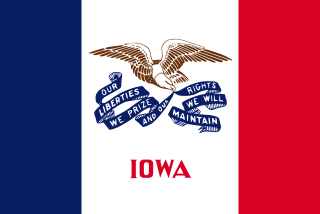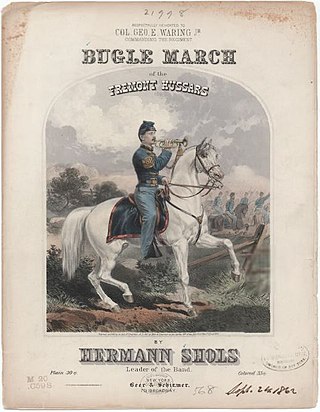| 2nd Missouri Cavalry Regiment Merrill's Horse | |
|---|---|
| Active | December 1861 to September, 1865 |
| Country | United States |
| Allegiance | Union |
| Branch | Cavalry |
| Engagements |
|
| Commanders | |
| Notable commanders | Col. Lewis Merrill |
| U.S. Cavalry Regiments | ||||
|
The 2nd Missouri Cavalry Regiment, also known officially as Merrill's Horse, [1] was a cavalry regiment that served in the Union Army during the American Civil War. The regiment was one of only a handful of Missouri regiments to be officially named as well as numbered.
The regiment was raised under the authority of Major General John C. Frémont, commander of the Western Department of the U.S. Army, headquartered at St. Louis, Missouri. The regiment was organized by Captain Lewis Merrill, a regular Army officer and a veteran of the prewar U.S. 2nd Dragoons. Serving as a colonel of volunteers, Merrill organized companies of volunteers from Missouri and other western states at St. Louis's Benton Barracks. Merrill enforced a level of discipline unusual for volunteer regiments, demanding a level of professionalism comparable to U.S. Regulars.
To distinguish the troops of his regiment, Merrill mandated a unique uniform. The front of the tunic featured a "horse-head" panel trimmed in cavalry yellow. The mandated cap was similarly unique: a sky-blue forage cap, with an orange welt (the branch color of pre-war Dragoon regiments) in honor of Merrill's service in the 2nd Dragoons. As with other areas of military discipline, Merrill allowed no deviation from his orders to his troopers in concerning their military appearance: "all additions to or alterations of this uniform as prescribed are positively prohibited and will not be tolerated under any circumstances."
Through most of 1862, Merrill's Horse was assigned the difficult mission of fighting guerrillas and irregular Confederate cavalry in north Missouri. Often operating with Federal Missouri State Militia cavalry, the regiment established a reputation of extreme aggressiveness and effectiveness in the counter-guerrilla mission. Later in the war Merrill's Horse would provide distinguished service in more conventional cavalry missions against regular Confederate units. However, in Arkansas, Tennessee, Georgia, and Alabama the regiment was repeatedly called on to return to the difficult specialist counterinsurgency mission of guerrilla fighting.
The regiment is unusual in that it has two official designation. It was officially raised as "Merrill's Horse", and is usually referred to by that designation in period U.S. Army Records. However, after General Fremont was replaced as commander of the Western Department by Major General Henry Halleck received a second official designation at the 2nd Missouri Volunteer Cavalry. [2] However, in almost all contemporary reports and records the regiment continued to be referred to as Merrill's Horse.
Organized at Benton Barracks, St. Louis, Missouri, by Captain Lewis Merrill, 2nd Cavalry Regiment, U.S.A., under authority of Major General John C. Frémont, commander of the U.S. Army's Department of the West. Merrill organized his regiment from September 3 to December 11, 1861. (An additional Co. "L" was organized at St. Louis, Mo., January 1, 1863, and Co. "M" was organized at Warrenton, Mo. on June 30, 1863.) Before organization of Regiment was completed, it was ordered to march to Springfield, Mo., September, 1861. Fremont's Campaign against Springfield, Mo., September–October. At Sedalia, Missouri, Mo., till January, 1862. Scout through Saline County, Missouri December 3–12, 1861. Expedition to Milford, Missouri December 15–19. Battle of Shawnee Mound or Milford, Blackwater River, December 18. Roan's Tan Yard, Silver Creek, January 8, 1862. Knob Noster, Missouri January 22. Attached to Department of Missouri September, 1861, to January, 1862. District of Northeast Missouri, Dept. of Missouri, to June, 1863. District of Southeast Missouri, Dept. of Missouri, to August, 1863. 1st Brigade, 1st Cavalry Division, Arkansas Expedition, to December, 1863. 2nd Brigade, 1st Cavalry Division, Army of Arkansas, to January, 1864. 2nd Brigade, 1st Cavalry Division, 7th Army Corps, Dept. of Arkansas, to May, 1864. 3rd Brigade, 2nd Division, 7th Army Corps, to September, 1864. 2nd Brigade, Cavalry Division, 7th Army Corps, to February, 1865. 2nd Brigade, Cavalry Division, District of West Tennessee, to muster out.
Moved to Northern Missouri and duty at Columbia, Glasgow, Sturgeon, Paris, Huntsville, Palmyra and Warrenton, operating against guerrillas and elements of the secessionist Missouri State Guard (MSG) January, 1862, to June, 1863. Expedition into Schuyler and Scotland Counties, against Porter's and Poindexter's MSG cavalry, July 12-August 8, 1862. Near Memphis, Mo., July 18. Brown Springs July 27. Moore's Mills, near Fulton, July 28. Kirksville August 6 (Detachment). Pursuit of Poindexter August 8–15, with skirmishes at Grand River, Lee's Ford, Chariton River and Walnut Creek, near Stockton, August 9. Switzler's Mill August 10. Little Compton Ferry, Yellow Creek, August 11. Roanoke September 6 (Detachment). Scotland and Boone Counties September 30 (Detachment). Joined Davidson's Cavalry Division at Pilot Knob June, 1863. Expedition to Little Rock, Ark., July 1-September 10. Grand Prairie August 17. Brownsville August 25. Bayou Metoe or Reed's Bridge August 27. Reconnaissance from Brownsville August 29. Bear Skin Lake, Ashby's Mills, September 7. Bayou Fourche and capture of Little Rock September 10. Pursuit of Price September 11–13. Near Little Rock September 11. Duty at Little Rock till March, 1864. Steele's Expedition to Camden March 23-May 3. Benton Road March 23–24. Okolona April 2–3. Prairie D'Ann April 9–12. Camden April 15–18. Moro Bottom April 25–26. Jenkins' Ferry, Saline River, April 30. Scatterville July 28. Duty in Arkansas till September. Operating against Price September and October. Booneville, Mo., October 9–12. Little Blue October 21. Big Blue, State Line, October 22. Westport October 23. Battle of Charlot October 25. Mine Creek, Osage River, Marias des Cygnes, October 25. Grierson's Expedition from Memphis against Mobile & Ohio Railroad December 21, 1864, to January 15, 1865 (Co. "E"). Near Memphis February 9 (Detachment). Moved to Chattanooga, Tenn., and duty operating against guerrillas in Georgia and Alabama and escorting trains from Chattanooga to Atlanta January to September, 1865. Mustered out September 19, 1865.
Regiment lost during service 3 Officers and 53 Enlisted men killed and mortally wounded and 1 Officer and 205 Enlisted men by disease. Total 262.
The 3rd Wisconsin Cavalry Regiment was a volunteer cavalry regiment that served in the Union Army during the American Civil War.

The 3rd Illinois Cavalry Regiment was a cavalry regiment that served in the Union Army during the American Civil War. It fought at such battles as Pea Ridge, Sherman's Yazoo campaign, the battle of Port Gibson, and the siege of Vicksburg.
The 32nd Iowa Infantry Regiment was an infantry regiment that served in the Union Army during the American Civil War.

The 4th Iowa Cavalry Regiment was a cavalry regiment that served in the Union Army during the American Civil War.
The 5th Iowa Cavalry Regiment was a cavalry unit from Iowa that served in the Union Army during the American Civil War.
The Missouri State Militia was a federally funded state militia organization of Missouri conceived in 1861 and beginning service in 1862 during the American Civil War. It was a full-time force whose primary purpose was to conduct offensive operations against Confederate guerrillas and recruiters as well as oppose raids by regular Confederate forces. The militia at one time numbered more than 13,000 soldiers, but this force was reduced to 10,000 soldiers, by the United States government.
8th Missouri Cavalry Regiment was a cavalry unit from Missouri that served in the Union Army during the American Civil War. The regiment was formed between 6 August and 15 September 1862. The regiment fought at Prairie Grove and Van Buren in 1862. The unit participated in Frederick Steele's expedition to Little Rock in 1863, fighting at Brownsville, Bayou Meto, and Bayou Fourche. From 1863 to 1865, the regiment remained in Arkansas, going on expeditions to suppress Confederate raiders and other occupation duties. The unit was mustered out of service on 20 July 1865. In January 1863, the regiment committed what has become known as the Huntsville Massacre.
The 12th Missouri Infantry Regiment was an infantry regiment that served in the Union Army during the American Civil War. The regiment was organized by Colonel Peter J. Osterhaus, a veteran of the respected 2nd Missouri Volunteer Infantry. The majority of the soldiers in the 12th were ethnic Germans. This intermixed German-American unit also had a large portion of its ranks filled by volunteers from Illinois.
The 5th Kansas Volunteer Cavalry Regiment was a cavalry regiment that served in the Union Army during the American Civil War.
The 9th Kansas Cavalry Regiment was a cavalry regiment that served in the Union Army during the American Civil War.
The 2nd Missouri Infantry Regiment was an infantry regiment, formed from a voluntary regiment using the same name, that served in the Union Army during the American Civil War.

The 4th Missouri Cavalry Regiment, also known as the Fremont Hussars, was a cavalry regiment that served in the Union Army during the American Civil War. Elements of the regiment fought at Pea Ridge, Whitney's Lane, Little Blue River, Byram's Ford, Westport, Marais des Cygnes, Marmiton River, and Mine Creek. Company C served at Iuka and Corinth while Company F was at Raymond, Jackson, Champion Hill, and Vicksburg.
The 22nd Ohio Infantry Regiment, originally mustered in as the 13th Missouri Infantry Regiment, was an infantry regiment in the Union Army during the American Civil War.
The 2nd Ohio Cavalry Regiment was a cavalry regiment that served in the Union Army during the American Civil War.
The 6th Missouri Cavalry Regiment was a cavalry regiment that served in the Union Army during the American Civil War. The regiment was organized in February 1862 by merging three independent cavalry battalions.
The 24th Missouri Infantry Regiment was an infantry regiment that served in the Union Army during the American Civil War.

The 1st Missouri Volunteer Cavalry Regiment was a cavalry regiment with three battalions that served in the Union Army during the American Civil War from 1861 to 1865.
The 17th Missouri Infantry Regiment was an infantry regiment that served in the Union Army during the American Civil War.
1st Indiana Cavalry Regiment, also known as the 28th Regiment of Volunteers was a cavalry unit that served in the Union Army during the American Civil War. Organized in August 1861, it did most of its fighting in the state of Arkansas. The regiment was in action at Cotton Plant, Helena, Bayou Fourche, Pine Bluff, Mount Elba, and Marks' Mills. One company was detached and fought in several actions in the Vicksburg campaign. The regiment was discharged in June 1865.

7th Missouri Cavalry Regiment was a cavalry unit from Missouri that served in the Union Army during the American Civil War. The regiment was formed on 20 February 1862 by merging Bishop's Cavalry Battalion with some unattached cavalry companies. The regiment fought at Independence, Lone Jack, Prairie Grove and Van Buren in 1862. The unit participated in Frederick Steele's expedition to Little Rock in 1863, fighting at Brownsville, Ashley's Mills, and Bayou Fourche. In 1864, the regiment went on the Camden Expedition and fought at Mount Elba and Marks' Mills. The remaining soldiers were consolidated with the 1st Missouri Volunteer Cavalry Regiment on 22 February 1865.